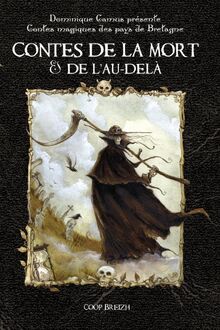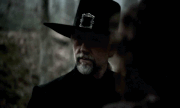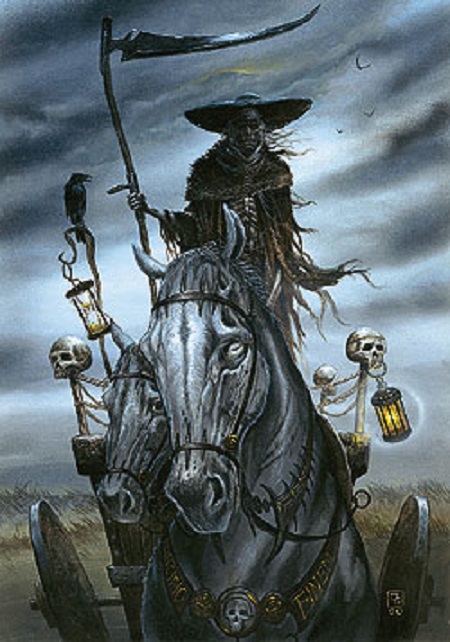| “ | Maro han barn ifern ien, Pa ho soign den e tle crena. (Breton for: "Death, judgment, cold hell; when man thinks about it he ought to shiver.") | „ |
| ~ What the Ankou is rumoured to say to passers-by |
| “ | War ma fé, eman zo un Ankou drouk. ("On my faith, this Ankou is a very nasty one.") | „ |
| ~ Breton saying about a year with more deaths than usual |

The Ankou is the harbinger of death of the Breton Mythology and folklore, known in the French region of Brittany, the remnants of the former eponymous kingdom, and some other regions of Celtic legacy. He is regarded as a protector for the deceased but a bad omen for the living. He has inspired many modern-day works and stories.
Description
In the beginning, the Ankou was described as a being tasked to perpetuate the cycle of life and death, wielding a hammer able to grant both, being similar to Suscellus, Gaul God of Nature, Life and Death; Dagda, Irish God of Druids and the Land of the Deads; and other Celtic deities with similar attributes. But as centuries went by, the Ankou became solely associated with Death and was progressively likened to a Grim Reaper-like psychopomp.
The Ankou appears in many tales gathered from oral tradition. As such his aspect varies from tale to tale. He is always described as a tall and thin figure clad in black Breton garments, wearing a large felt hat concealing his face, standing up in a creaking cart similar to the ones used during the Middle-Age to gather corpses, in which he gathers the souls of the deads, and wielding a scythe whose blade is turned outward for striking forward instead of reaping, which glows under the moonlight.
He is sometimes depicted as a man-shaped living shadow, sometimes as a skeleton whose head is rotating without end like a weather vane, so that no death could escape his watch, sometimes with glowing eyes. However, his most common depiction is that of a tall and skinny ageless man, with long, white hair and a gaunt, haggard face, wearing a black cloak or cape. His cart is said to be drawn by two horses, one in perfect health and the other skinny and ill-looking, although some speak of four horses, and others speak of just one gaunt-looking one. The Ankou is also said to be followed by two ghostly figures who walk next to his cart, leading his horses and helping him carry the dead souls in.
The Ankou only walks the roads of Brittany during night-time. He rules over the other side of the Veil and the deads, whom he allegedly leads in sacred processions at times. Despite this, he is more Death's foot-worker than Death itself; being usually an undead individual who must protect the departed souls of and lead them to the Afterlife for a defined amount of time, before reaching Afterlife in his turn. It is said that there are more than one Ankou, one for each parish.
Although the Ankou is always described as an adult man, the role is fulfilled by the last dead person of the year (sometimes by the first) who must watch over his parish until he is replaced. Another less common source states that the Ankou was a tyrannical prince during his lifetime, who lost a challenge issued by Death and was condemned to an eternity of servitude.
Role in Breton folklore
The Ankou is said to roam around graveyards, watching over the dead souls residing here. When his cart is empty, he charges it with heavy stones, removing some whenever he takes a soul in. As such, it is believed that when the noise of a falling stone is heard during a funeral wake, it is the Ankou who is readying his cart for the soul of the recently departed. Some also say that he sharpens his scythe on a human bone.
The Ankou is an omen of death to living people, who is said to knock on the door of the houses in which someone is about to die, sometimes emitting a warning, or an ominous wail similar to that of a Banshee. He rarely uses his scythe to claim a life, for his mere presence is often lethal. Those who hear the creaking of the Ankou's cart are said to die or to see one of their loved ones die very soon. And those who see him are said to die within the year. However, he is known to spare those who help him. In some tales, when the Ankou meets people he merely (albeit ominously) reminds them that death is inevitable for anyone, no matter the age, wealth or political power. In gloomier ones, seeing the Ankou, talking to him or crossing his path condemns people to an imminent demise.
It is said that the Ankou waits in every new house to claim the life of the first living being to enter it, be it an animal or an egg about to hatch. Because of this, it is tradition in the Breton Commune of Quimperlé to sacrifice a rooster and to spread its blood on the foundations of every house which is being built. During Christmas Eve, which the Bretons call the "Night of Wonders", the Ankou roams anonymously among the crowd attending the midnight mass. There, he brushes past all of those who will die before the New Year.
The Ankou's omen of death is not always a bad one however. In most tales, the ones who saw him have enough time to organize their business and their succession before he comes to claim their life. Some even say that the Ankou only shows himself to those about to die, and that seeing him is a warning rather than an omen. The Ankou never bears ill will towards anyone and, despite being a no-nonsense man of few words; he is always polite when addressing someone, including those whom he came to fetch. He merely follows his duty without regard for pleas of promises of reward, since death cannot be escaped, no matter how hard we try.
The Blocked Road
In this tale, three brothers come back home at night after a party and, being quite tipsy, decide to pull a prank on the first carriage to travel by the nearby road, by blocking it with a dead tree. Later this night, they are awoken by someone banging violently at their door, who orders them to go and remove the tree which is blocking his path, as he knows that it was them who put it there.
The frightened brothers comply without question. They then discover that the stranger is none other than the Ankou himself, who states that since he lost one hour of his time due to their prank, they shall all die one hour sooner. He adds that they are lucky to have complied immediately, since otherwise, they would have owed him one year of their lives for each minute he would have lost with their prank.
There is a variation of this tale in which three drunken brothers (or friends) come home at night and come across the Ankou, whom they do not recognize. Two of them start insulting the stranger and throwing stones at him until one breaks the axle of his cart. While the two flee, the third, ashamed by his comrade’s actions (and in some versions his own as well), cuts a branch and gives it to the stranger to repair his cart, along with his shoe laces to tie it. In the morning, the first two are found dead while the third’s hair turns white.
Death's Cart
This tale is about a young man who one night recognizes the creaking noise made by the Ankou's cart. But instead of fleeing, he decides to hide in order to see the Harbinger of Death by his own eyes without being noticed. As the cart passes nearby, one beam of its wheels breaks and the Ankou orders one of his ghostly aides to fetch a branch in the bush in which the young man is hiding to repair it. The Ankou does not notice the young man, but he still pays the price for his bold curiosity, as he catches a fever and dies the following day.
The Blacksmith's Story
This tale is about Fanch ar Floc'h, a skilled blacksmith who is constantly working, since he always accepts more tasks than he can perform. During Christmas Eve, he decides to skip the midnight mass to finish his most important task. He asks his wife and children to pray for him, and they warn him that he must have stopped work at all costs by the time the bells ring the midnight hour, lest he gets cursed.
Unfortunately, Fanch is so absorbed in his task that he does not hear the bell and continues working. Then, a stranger clad in black, whose hat conceals his face, knocks at his door and informs him that the bell has already rang. The stranger asks Fanch to repair his scythe, which he does despite wondering why its blade is turned outward. When it is done, the stranger reveals himself to be the Ankou, who has come to claim the life of the one who neglected the Night of Wonders. Since Fanch has repaired his scythe, the Ankou allows him to wait for his family's return to say his goodbye and ask for a priest, before coming back to take his soul.





